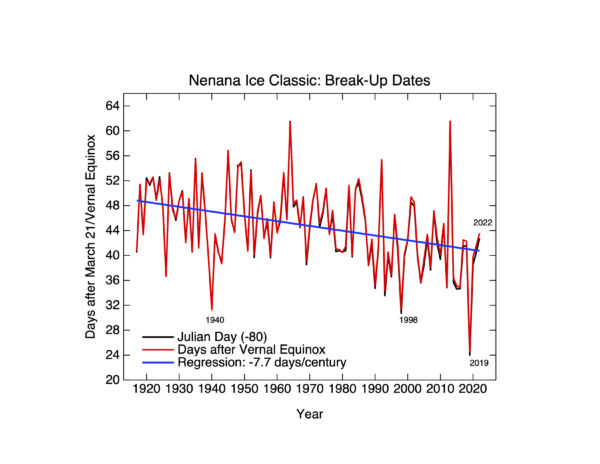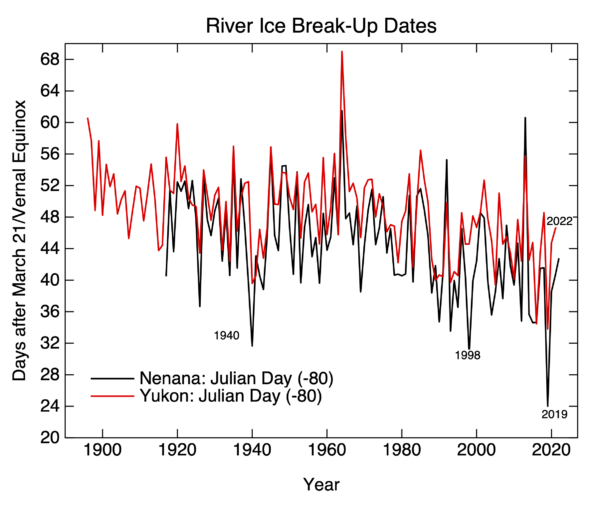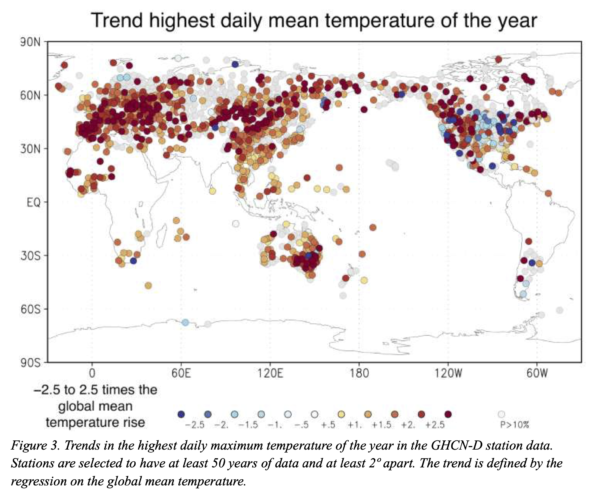Some of the authors of a recent commentary on k-scale modeling respond to RealClimate.
[Read more…] about Overselling k-scale? HmmClimate impacts
River Ice break-up trends 2022
As in previous years, the spring break-up of river ice on the Tanana River at Nenana and the Yukon River at Dawson City in Canada (new! h/t Ed Wiebe), is a great opportunity to highlight phenology that indicates that the planet is in fact reacting to the ongoing global warming. As we’ve done in previous years, the Nenana dates can be plotted and show a clear trend towards earlier break-ups (by about 8 days/century over the whole record, or 13 days/century since 1975).

2022 was on trend, and in 2014, I noted that May 3rd was the most likely date given the trends until then.
Dawson City in the Yukon is about 250 miles east of Nenana which is close enough for the seasonal anomalies in climate to be quite highly correlated. So one might expect that the break-up dates would be similarly correlated… and indeed they are:

The ice at Dawson breaks up on average 3.8 days later than the ice at Nenana (5.1 days this year), but the correlation between the two series is an impressive 0.82. There have been 15 times the ice went out within 24 hours of each other and in 1963 they broke up less than 3 minutes apart! The trends are likewise very similar 7.7±3.8 days/century for Nenana, compared to 6.5±3.1 days/century since 1917. This pretty much puts paid to the occasional claim of the urban heat island in Fairbanks affecting the water and causing the trend.
[Update: I misunderstood the Yukon river break up website, and erroneously stated that the break-up was on May 2nd. It was not. I’ll update this again when it has. Apologies.]
[Update II: The Yukon river ice broke up on May 7, and I’ve updated the graph and text.]
Digital Twinge
A couple of weeks ago the EU announced that they were funding a project called DestinE (Destination Earth) to build ‘digital twins’ of the Earth System to support policy making and rapid reaction to weather and climate events.
While the term ‘digitial twin’ has a long history in the engineering world, it’s only recently been applied to Earth System Modeling, and is intended (I surmise, as does Bryan Lawrence) to denote something more than the modeling of either weather or climate that we’ve been doing for years. But what exactly? And is it an achievable goal or just a rebranding effort of things that are happening anyway?
[Read more…] about Digital TwingeMaking predictions with the CMIP6 ensemble
The CMIP6 multi-model ensemble is a unique resource with input from scientists and modeling groups from around the world. [CMIP stands for the Coupled Model Intercomparison Project, and it is now in its 6th Phase]. But as we’ve discussed before (#NotAllModels) there are some specific issues that require users to be cautious in making predictions. Fortunately, there are useful ‘best practices’ that can help avoid the worst pitfalls.
A new paper by McCrystall et al that has just appeared in Nature Communications illustrates these issues clearly by having some excellent analyses of the changes in Arctic precipitation regimes at different global warming levels, and examining the sensitivity of their metrics to both local and Arctic warming, but unfortunately relying on the CMIP6 multi-model mean for their headline statements and press release.
[Read more…] about Making predictions with the CMIP6 ensembleReferences
- M.R. McCrystall, J. Stroeve, M. Serreze, B.C. Forbes, and J.A. Screen, "New climate models reveal faster and larger increases in Arctic precipitation than previously projected", Nature Communications, vol. 12, 2021. http://dx.doi.org/10.1038/s41467-021-27031-y
The definitive CO2/CH4 comparison post
There is a new push to reduce CH4 emissions as a possible quick ‘win-win’ for climate and air quality. To be clear this is an eminently sensible idea – as it has been for decades (remember the ‘Methane-to-markets’ initiative from the early 2000s?), but it inevitably brings forth a mish-mash of half-remembered, inappropriate or out-of-date comparisons between the impacts of carbon dioxide and methane. So this is an attempt to put all of that in context and provide a hopefully comprehensive guide to how, when, and why to properly compare the two greenhouse gases.
[Read more…] about The definitive CO2/CH4 comparison postWe are not reaching 1.5ºC earlier than previously thought
Guest commentary by Malte Meinshausen, Zebedee Nicholls, and Piers Forster
Of all the troubling headlines emerging from the release of the Intergovernmental Panel on Climate Change (IPCC) WG1 report, one warning will surely dominate headlines in the next days and weeks: Earth is likely to reach the crucial 1.5℃ warming limit in the early 2030s.
In 2018, the IPCC Special Report on 1.5C warming stated in its summary for policy makers that the world was likely to cross the 1.5℃ threshold between 2030 and 2052, if current warming trends continue.
In this latest AR6, a more comprehensive assessment was undertaken to estimate when a warming level of 1.5℃ might be reached. As a result, some early media reports suggest 1.5ºC warming is now anticipated 10-years earlier than previously assumed (AFR, THE TIMES).
We want to explain here why that is not backed up by a rigorous comparison of the SR1.5 and AR6 reports. In fact, the science in the previous SR1.5 report and the new AR6 report are remarkably consistent.
[Read more…] about We are not reaching 1.5ºC earlier than previously thoughtThe IPCC Sixth Assessment Report

Climate scientists are inordinately excited by the release of a new IPCC report (truth be told, that’s a bit odd – It’s a bit like bringing your end-of-(seven)-year project home and waiting anxiously to see how well it will be received). So, in an uncharacteristically enthusiastic burst of effort, we have a whole suite of posts on the report for you to read.
- AR6 of the Best. Half a dozen takeaways from the report from Gavin
- New (8/13): Sea Level Rise in AR6 from Stefan
- A Tale of Two Hockey Sticks by Mike
- #NotAllModels discusses the use (and mis-use) of the CMIP6 ensemble by Gavin
- We are not reaching 1.5ºC earlier than previously thought from guest authors Malte Meinshausen, Zebedee Nicholls and Piers Forster
- New (8/12): Deciphering the SPM AR6 WG1 Code by Rasmus
- New (8/12): A deep dive into the IPCC’s updated carbon budget numbers from guest author Joeri Rogelj
If/when we add some more commentary as we digest the details and we see how the report is being discussed, we’ll link it from here. Feel free to discuss general issues with the report in the comments here, and feel free to suggest further deep dives we might pursue.
Climate adaptation should be based on robust regional climate information
Climate adaptation steams forward with an accelerated speed that can be seen through the Climate Adaptation Summit in January (see previous post), the ECCA 2021 in May/June, and the upcoming COP26. Recent extreme events may spur this development even further (see previous post about attribution of recent heatwaves).
To aid climate adaptation, Europe’s Climate-Adapt programme provides a wealth of resources, such as guidance, case studies and videos. This is a good start, but a clear and transparent account on how to use the actual climate information for adaptation seems to be missing. How can projections of future heatwaves or extreme rainfall help practitioners, and how to interpret this kind of information?
[Read more…] about Climate adaptation should be based on robust regional climate informationRapid attribution of PNW heatwave
Summary: It was almost impossible for the temperatures seen recently in the Pacific North West heatwave to have occurred without global warming. And only improbable with it.
It’s been clear for at least a decade that global warming has been in general increasing the intensity of heat waves, with clear trends in observed maximum temperatures that match what climate models have been predicting. For the specific situation in the Pacific NorthWest at the end of June, we now have the first attribution analysis from the World Weather Attribution group – a consortium of climate experts from around the world working on extreme event attribution. Their preprint (Philip et al.) is available here.

A potential rule of thumb for hourly rainfall?
Future global warming will be accompanied by more intense rainfall and flash floods due to increased evaporation, as a consequence of higher surface temperatures which also lead to a higher turn-around rate for the global hydrological cycle. In other words, we will see changing rainfall patterns. And if the global area of rainfall also shrinks, then a higher regional concentration of the rainfall is bound to lead to more intense downpours (the global rainfall indicator is discussed here).
[Read more…] about A potential rule of thumb for hourly rainfall?